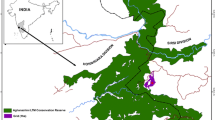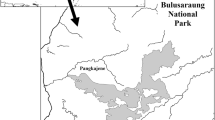Abstract
The per capita home range area of Japanese macaques,Macaca fuscata, is significantly smaller in evergreen forest than in deciduous forest, though a corresponding difference in food resource utilization patterns has never been described. The present study compared the home range utilization pattern of Japanese macaques living in two habitats: the Yakushima population inhabits an evergreen forest, while the Kinkazan population inhabits a deciduous forest. We found that in the Yakushima population, (1) food density was higher; (2) inter-feeding bout sites distance was shorter; (3) daily travel distance was shorter; (4) home range size was smaller; and (5) the unit value of the main home range was higher, than in the Kinkazan population. Yakushima groups utilized a small home range area intensively, compared to Kinkazan groups. We also found that a Yakushima group shared 24% of its main home range with neighboring groups, though a Kinkazan group shared only 10% with other groups. It is supposed that food distribution affects daily ranging pattern, and ultimately the social relationships between groups in Japanese macaques.
Similar content being viewed by others
References
Agetsuma, N.;Nakagawa, N. 1998. Effects of habitat differences on feeding behaviors of Japanese monkeys: comparison between Yakushima and Kinkazan.Primates, 39: 275–289.
Aldrick-Blake, F. P. G. 1980. Long-tailed macaques. In:Malayan Forest Primates: Ten Years' Study in Tropical Forest,Chivers,D. (ed.), Plenum Press, New York & London, pp 147–165.
Chivers, D. J.;Reamaekers, J. J.;Aldrick-Blake, F. P. G. 1975. Long-term observations of siamang behavior.Folia Primatol., 23: 1–49
Iwamoto, T. 1987. Food and energetics of provisioned wild Japanese macaques (Macaca fuscata). In:Ecology and Behavior of Food-enhanced Primates Groups,Fa,J. E.;Southwick,C. H. (eds.), Alan R. Liss New York, pp. 79–94.
Izawa, K. 1988. The ecological study of wild Japanese monkeys living in Kinkazan Island, Miyagi Prefecture.Bull. Miyagi Univ. Educ., 23: 1–19.
Maruhashi, T.;Takasaki, H. 1996. Socio-ecological dynamics of Japanese macaque troop ranging. In:Evolution and Ecology of Macaque Societies,Fa,J. E.;Lindburg,D. G. (eds.), Cambridge Univ. Press, Cambridge, pp. 146–159.
Nakagawa, N. 1989. Bioenergetics of Japanese monkeys (Macaca fuscata) on Kinkazan Island during winter.Primates, 30: 441–460.
Saito, C.;Sato, S.;Suzuki, S.;Sugiura, H.;Agetsuma, N.;Takahata, Y.;Sasaki, C.;Takahashi, H.;Tanaka, T.;Yamagiwa, J. 1998. Aggressive intergroup encounters in two populations of Japanese macaques (Macaca fuscata)Primates, 39: 303–312.
SAS Institute Inc. 1988.SAS Procedures Guide, Release 6.03.Cary (ed.), SAS Institute Inc., North Carolina.
Takahata, Y.;Suzuki, S.;Hill, D. 1994. Troop extinction and fusion in wild Japanese monkeys of Yakushima Island, Japan.Amer. J. Primatol., 33: 317–322.
Takasaki, H. 1981. Troop size, habitat quality and home range area in wild Japanese macaques.Behav. Ecol. Sociobiol., 19: 277–281.
Takatsuki, S.;Gorai, T. 1994. Effects of Shika deer on the regeneration of aFagus crenata forest on Kinkazan Island, northern Japan.Ecol. Res., 9: 115–120.
Author information
Authors and Affiliations
About this article
Cite this article
Maruhashi, T., Saito, C. & Agetsuma, N. Home range structure and inter-group competition for land of Japanese macaques in evergreen and deciduous forests. Primates 39, 291–301 (1998). https://doi.org/10.1007/BF02573078
Received:
Accepted:
Issue Date:
DOI: https://doi.org/10.1007/BF02573078




